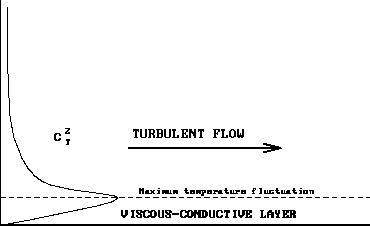



Next: The cold mirror
Up: Physical description of
Previous: Free convection
If a forced flow interacts with buoyancy forces the wall
region and, in part, the conductive layer
will be destabilized by the velocity gradients.
In the turbulent region (see fig.  ) the turbulent
diffusivity will increase rapidly with the distance from the surface,
with a consequent reduction of the temperature fluctuations.
The profile of
) the turbulent
diffusivity will increase rapidly with the distance from the surface,
with a consequent reduction of the temperature fluctuations.
The profile of  above the surface will be such
that the maximum is at the interface
between the viscous-conductive layer and the overlying turbulent layer
but will decrease much more rapidly than in the free convection case.
above the surface will be such
that the maximum is at the interface
between the viscous-conductive layer and the overlying turbulent layer
but will decrease much more rapidly than in the free convection case.

Figure: Temperature and velocity fluctuations in presence of
forced flow over a horizontal plane
All the experimental and anedoptical evidence shows that very little
seeing will be produced if a forced convection regime is fully established.
A more significant case is the intermediate situation in which a weak
air flow interacts with free convection producing a mixed convection
regime, characterized by the Froude number:

where U is the mean flow speed.
When the Froude number is large, forced convection is dominant and
therefore
mirror seeing should disappear. When the Froude number is small, free
convection is dominant. In-between one has a mixed convection case,
in which case identity of the Froude number is required for any
similarity between tests at different scales.
In section  we will show that the rate of seeing
produced by a given surface-air temperature difference is indeed a
function of the Froude number.
we will show that the rate of seeing
produced by a given surface-air temperature difference is indeed a
function of the Froude number.
Lorenzo Zago, zago@elgc.epfl.ch,
Sun Feb 26 22:57:31 GMT+0100 1995
 ) the turbulent
diffusivity will increase rapidly with the distance from the surface,
with a consequent reduction of the temperature fluctuations.
The profile of
) the turbulent
diffusivity will increase rapidly with the distance from the surface,
with a consequent reduction of the temperature fluctuations.
The profile of  above the surface will be such
that the maximum is at the interface
between the viscous-conductive layer and the overlying turbulent layer
but will decrease much more rapidly than in the free convection case.
above the surface will be such
that the maximum is at the interface
between the viscous-conductive layer and the overlying turbulent layer
but will decrease much more rapidly than in the free convection case.





